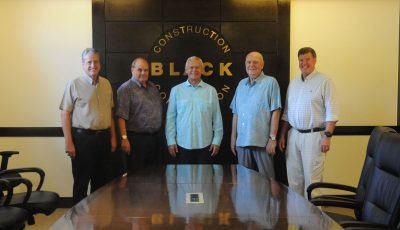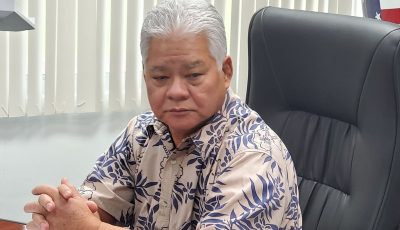CHAMBER’S 8-POINT ECONOMIC DEV’T ROADMAP:
‘Focus on investments, labor, government operations’
Last of four parts
The Saipan Chamber of Commerce will be working closely with the administration of Gov. Ralph DLG Torres and Legislature as the Commonwealth’s economy continues to improve after suffering more than five years of inactivity.
“The general membership, through its board of directors, pledges to work throughout the coming years to make our economy better for every resident of the Commonwealth,” said in the eight-point Economic Development Roadmap that they presented both to Gov. Ralph DLG Torres and Lt. Gov. Victor B. Hocog last week.
“We will gladly accept the suggestions of the CNMI administration and Legislature on how to best meet to begin work that has been outlined,” added the report.
Torres said they have always welcomed suggestions from different sectors of the community. “It is always important to listen to all stakeholders of our community and share ideas on how to improve our Commonwealth.
“The presentation offered some worthwhile proposals that we are interested in pursuing, and contained projects that we are already in the process of seeing through,” Torres added.
Investment
The Chamber said Saipan’s economy is changing with the entry of electronic and live gambling. The likes of Club C and Club 88 had widened the gaming industry aside from the remaining poker and pachinko arcades. Imperial Pacific International is currently operating a live training facility as they await the opening of its multibillion-dollar Grand Mariana Casino & Hotel Resort early next year.
Other investors have been coming in the form support businesses like new hotels and even brand name restaurants. “With these new endeavors comes new opportunity, both for business owners and employees. Wages will need to increase and are expected to match stateside levels.”
The Chamber said that the tax base needs to sustain and provide essential public services. They are also encouraging eligible investors to apply to the U.S. Citizenship and Immigration Services EB-5 investor program under the Consolidated Natural Resources Act; tax investment opportunities to further attract other investors, investment opportunities via tax credits; tax credits for low-income housing and other developments; follow through on free trade zone and qualifying certificate amendments and implementation; development for business collateral; comprehensive one-start business development center; and economic diversity.
The Chamber is also suggesting that the island would benefit from the “MICE component” or meetings, incentives, conventions, and exhibits. Saipan, however, currently has no facility big enough to host such events.
“Guam has [the University of Guam] Fieldhouse and the Paseo Stadium for large gatherings, which stimulate business and improve the economy. [The] government might consider subsidizing with the private sector to provide some initial spaces,” said the Chamber report.
A space that could hold 500 to 800 or even up to 1,000 is needed and it should be an indoor facility with most of the off-island visitors would have a harder time acclimatizing on Saipan’s tropical type of weather.
The government should also maintain a healthy relationship with the current and future air carriers that would support business efforts to further increase their traffic to and from the island.
Labor
The Chamber report also pointed out the lack of qualified and trained labor force on Saipan that would support all of the economic development that are taking place.
“There will be fewer in the employment market as our economy begins to rebound. There needs to be a better understanding of the possibilities for local labor development now present with immigration and labor authority, and enforcement as recently federalized.”
Chamber listed the minimum wage issue: business survival against maximum wages; increase local employment through profitable corporations; education to enhance local employment skills; extension of USCIS CW-1 permit transition period; and re-qualify prevailing wage rate survey data and reports in a timely fashion as important factors in the local labor market.
Government operations
The Chamber is also suggesting the government should consider 21 points under this section, which the public and private sectors needs to properly utilize. They are:
• To create a task force to study enforcement situations and techniques at Revenue at Revenue and Taxation.
•
• Scholarships need to be based on academic achievement
•
• Scholarship awardees return to work minimum periods
•
• Better use of existing buildings owned by government
•
• Retirement benefits need to be reduced
•
• Double dipping issue
•
• C-Span type of broadcast of legislative sessions
•
• Enforce existing automobile minimum purchase system
•
• Economic expert consultancy
•
• Pursue compact impact reimbursement
•
• Pursue additional military rest and recreation, and financial disclosure management use
•
• Reduction of paid vacations
•
• Expenditures mirror revenue projections
•
• Place existing government employees where needed most
•
• Retain government accounts receivable collections firm
•
• Percentage reduction in salary versus rebate removal
•
• No new taxes until economy rebounds
CIP funding
Increase government revenue not through increased taxation, but within areas of existing commerce and trade
Source increased federal grants and funding as a direct result of the implementation of federal authority of immigration and wage rates; and
Undertake a third economic impact analysis by McPhee and Conway



























